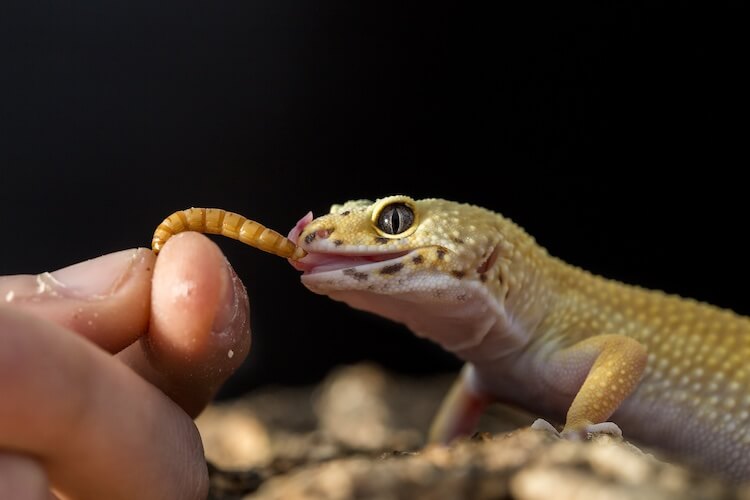
Leopard geckos are one of the most popular lizards for first-time keepers. Their spotted colors and friendly personalities make them a popular pet.
But, what do Leopard Geckos eat and how much should you feed them?
Understanding how to feed a balanced diet and the best foods to give is very important.
In the wild Leopard geckos are carnivores and eat a diet of insects and other small animals.
Many first-time owners do not realize they need gut-loaded insects in the diet, not just straight from container to mouth. This makes the insects full of vitamins and minerals to keep your lizard healthy.
This article will discuss everything you should know about feeding Leopard geckos. We also share feeding charts, food lists and the best feeding timetables…
What Do Leopard Geckos Eat?
Leopard geckos are opportunistic carnivores that will eat whatever they can catch. In the wild, these lizards eat beetles, spiders, crickets and scorpions. They sometimes also prey on small snakes, baby mice and other types of geckos.
They will try and eat any animal small enough to fit into their mouth. There are even reports of hungry geckos cannibalizing hatchlings, though this is quite rare.
Instead of waiting for their prey to walk past, leopard geckos will search for and chase them. They hunt by sight and will stalk insects slowly and purposefully. During the hunt, but before striking, they often shake or vibrate the tips of their tails. This helps to spook their prey into moving.
Once they strike they shake their prey quickly to kill it. Dead prey is normally ignore, but sometimes a Gecko may lick it to determine its edibility.
Watching this lizard hunt can be very entertaining. They are small but fierce and capable hunters with excellent eyesight and a keen sense of smell. They also have powerful jaws with 100 small, sharp teeth that are able to be replaced every three or four months.
Leopard geckos will eat as often as they can. Their high activity levels, and a lack of prey, means that wild species rarely become fat or obese. In fact, they are usually underweight. Wild individuals typically weigh around 27 grams, while larger pets can reach 90 grams.
Pet leopard geckos are prone to gaining weight because of their reduced activity levels and high-quality food. To prevent obesity, it is important to feed your gecko on a schedule and monitor any weight gain.
Hatchlings and juveniles should grow faster and eat more frequently than adults. Species over two years old should no longer gain weight and so should eat less often, though their prey size can be larger.
Leopard Gecko Diet
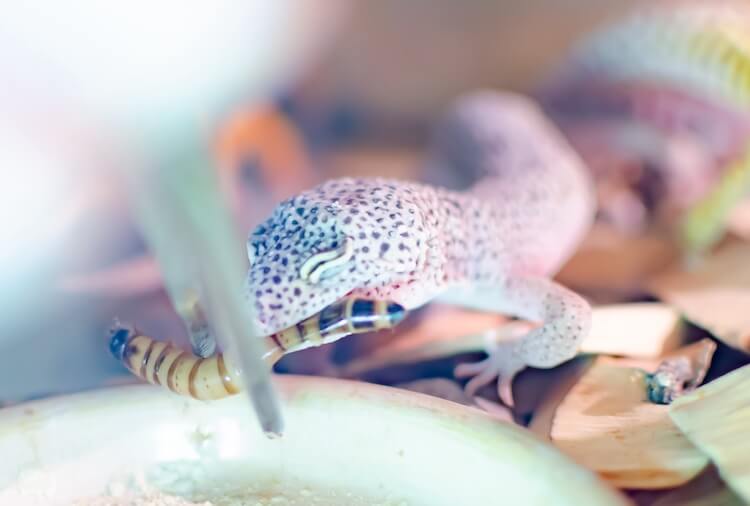
A balanced diet is very important to a healthy leopard gecko.
Crickets, cockroaches, mealworms, waxworms and hornworms are all healthy and safe foods for a leopard gecko to eat. However, not all of these foods are equal in terms of nutrition.
The most common leopard gecko Food is house crickets, as they are sold in bulk at pet stores. However, these insects tend to smell and can be noisy. Mealworms and Dubia roaches are a much better choice.
Waxworms are also commonly fed, but are high in fat and low in protein. This means they are not ideal for your leopard gecko’s diet and should only be used as treats.
In their natural habitat, these lizards prey on many different types of animals. You should try to mimic this natural variation in their diet. You will also need to pay attention to the nutrient content of the different insects you are feeding.
Baby Feeding Schedule
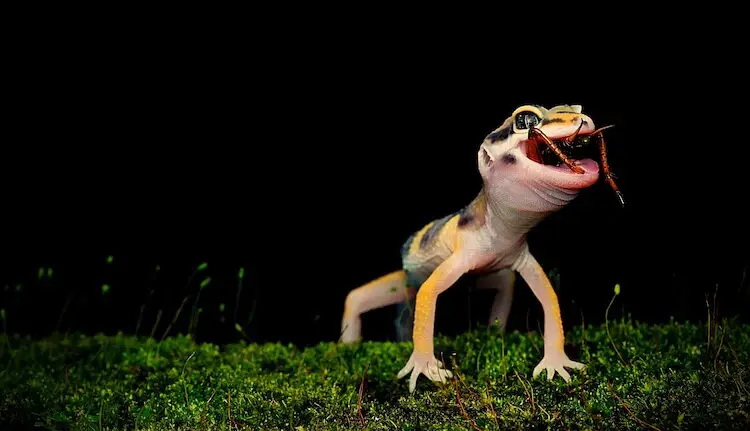
Babies are greedy eaters and have a very high metabolism. Because of their rapid growth and development they need to eat more often than adults, preferably once per day.
Baby geckos are usually more skittish than adults and are less likely to take food from your hand or tongs. It is best to feed them using a small dish. Using a small dish also allows the prey to move around and attract their attention.
Generally, baby leopard geckos should be given as many small crickets or roaches as they can eat in 10 minutes. After 10 minutes any uneaten food should be removed. It is safe and healthy for young geckos to eat every day and it helps fuel their rapid growth.
Here is an example feeding chart for a baby leopard gecko:
| Day | Food and Quantity |
|---|---|
| Monday | 5 to 7 small crickets |
| Tuesday | 6 to 8 small dubia roaches |
| Wednesday | 3 to 4 small crickets and 3 to 4 small roaches |
| Thursday | 5 to 7 small crickets |
| Friday | 6 to 8 small roaches |
| Saturday | 3 to 4 crickets and 3 to 4 roaches |
| Sunday | 3 to 4 crickets and 1 small hornworm or waxworm |
Provided you are giving them small food items there is little to no danger of overfeeding. If your baby still seems hungry after eating seven crickets, then offer a few more. In general, you should feed to their appetite.
Like adults, baby geckos may lose their appetite when shedding. However, this should only be temporary. A baby not eating for four days or more is cause for concern.
As they grow, leopard geckos can eat larger prey less often.
Once they reach four inches (usually around six months) you can introduce mealworms and larger crickets or roaches. Species under four inches long should not be fed mealworms because of the difficulty in digesting chitin.
After ten months you can start to gradually transition to medium-sized foods. At 12 months geckos are fully grown and can be fed on an adult feeding schedule.
Adult Feeding Schedule
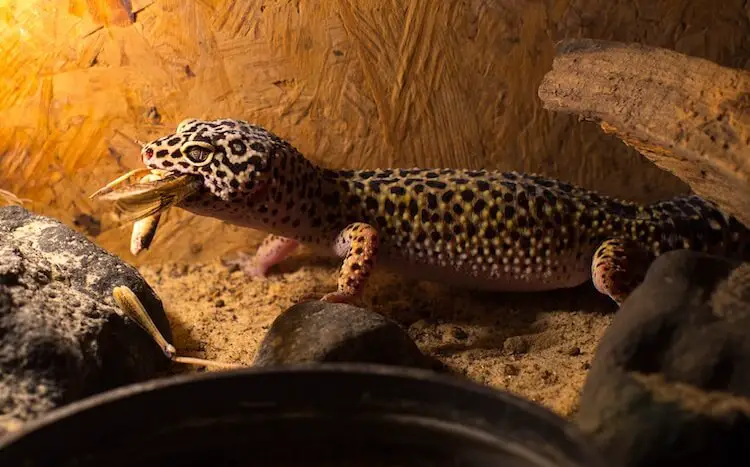
Adults do not need to eat as much as babies and juveniles do. These lizards store fat in their tails, so they always have a supply of extra energy if they need it.
Fully grown leopard geckos (individuals older than 10 months) should be fed every two to three days.
Leopard geckos are not active during the day. The best time to feed them is in the evening, just after turning off the lights. This is when they will be active and most interested in food.
See the chart below for an example weekly feeding schedule:
| Day | Food and Quantity |
|---|---|
| Monday | 4 to 5 large crickets and 1 to 2 mealworms |
| Wednesday | 5 to 6 medium or 7 to 8 small Dubia roaches |
| Friday | 3 to 4 large crickets, 2 mealworms and 1 hornworm |
You can feed adults from a dish, with tongs or by hand.
Many leopard geckos take to being hand fed quite well, it is also an enjoyable experience for both the lizard and you. Feeding insects by hand also stops them from escaping into your gecko’s enclosure. Free-running insects, especially crickets, can bite and injure a sleeping gecko.
Your leopard gecko’s stomach should be slightly round, when viewed from the side, after each meal. But, it should not be bloated or tight.
Make sure that prey is the right size for your leopard gecko.
A good rule of thumb is to feed your lizard insects that are no larger than the space between its eyes.
This is especially true for larger foods like crickets, cockroaches and hornworms. Young juveniles can eat crickets or cockroaches around ¼ to ½ inches long. A healthy adult can eat prey up to an inch in length.
Leopard geckos are normally enthusiastic eaters, but adults may become disinterested in food when getting ready to shed. This is normal, but you should take your lizard to a vet if it refuses to eat for more than two weeks.
Feeding different insects will keep your leopard gecko interested in its food and provides a balanced diet.
Vitamins and Supplements
It is important to gut-load insects at least 12 hours before feeding them to a leopard gecko. You should also dust them with a vitamin and calcium supplement directly before feeding.
There are two main supplements required for leopard geckos:
- Multivitamin
- Calcium
Both supplements are commonly found in a powder form, sometimes as a combined vitamin and calcium powder. Supplements help to provide all the micronutrients your pet needs for a long and healthy life.
Dust feeder insects with a quarter teaspoon of the calcium and multivitamin powders directly before feeding. Dusting insects too early gives them time to remove the powder by grooming, so dust them no later than 5 minutes prior to feeding.
Insects should be dusted every meal for adults and every other meal for juveniles.
Calcium powder can be found with or without vitamin D3. Vitamin D3 is essential for healthy bones. Too little vitamin D3 causes metabolic bone disease which is a serious issue that can be fatal.
There are some who argue that offering D3 powder along with a UVB light can lead to an overdose. But, the general consensus is that too little D3 is a much bigger problem than too much. For this reason, we recommend that you use a vitamin D3-enriched calcium powder.
Multivitamins are just as important as calcium.
A multivitamin is an excellent way to make sure your leopard gecko is getting all the nutrients it needs. It also supplements the loss of prey diversity.
Leopard Gecko Food List
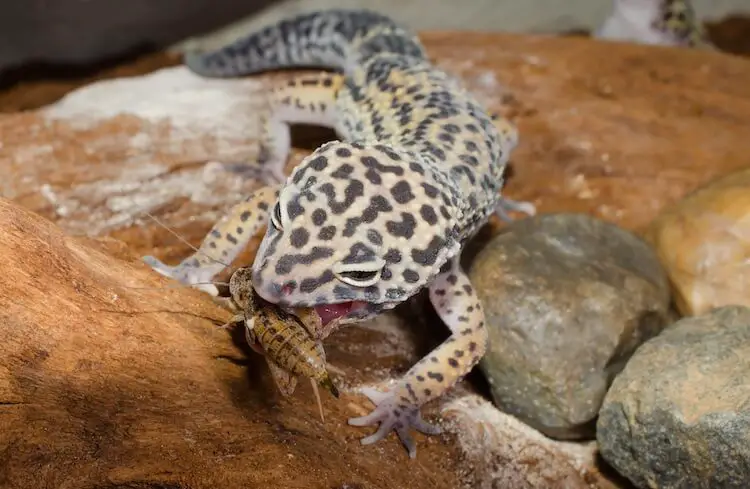
Leopard geckos are insectivorous. This means they eat insects and need to be fed a 100% live prey diet. Some of the best foods for leopard geckos include:
- House crickets
- Mealworms
- Superworms
- Dubia cockroaches
Both Dubia cockroaches and crickets are high in protein and nutrients.
Gut loading feeder insects with leafy greens, and other fruits and vegetables, is a great idea and will help your lizard get the most nutrition out of its food.
A varied diet is key to keeping your gecko not only healthy but happy. Most leopard geckos enjoy eating several different foods and the occasional treat.
The number of different leopard gecko foods can feel overwhelming for first time owners. The list below will give you an overview of what foods are best for your gecko and what foods you should avoid.
Can Leopard Geckos Eat:
Worms: Yes. They can eat worms occasionally, but most tend to dislike the slimy secretions given off by worms. Worms have a high water content but are low in nearly all other nutrients.
Mealworms: Yes. Mealworms are a good food for leopard geckos. However, it is important to supplement them with other insects because mealworms have a lot of chitin, which is hard to digest.
Crickets: Yes. House crickets and banded crickets are the number one feeder insect for leopard gecko. Use tongs or a feeding dish to serve crickets.
Caterpillars: Maybe, it depends on the species. Some caterpillars, like silkworms and waxworms, can be fed as treats. Other species and many wild caterpillars are toxic or covered in stinging hairs.
Weevils: No. Weevils have a tough, chitinous shell. They are generally too tough for baby geckos and too small for adults.
Pinky mice: Yes. Pinky mice can be given to a breeding female. It helps them build fat after laying eggs. Male geckos should not be given more than one pinky a month.
Nightcrawlers: Yes. However, like worms, nightcrawlers are not very nutritious and many leopard geckos do not like the texture. Large nightcrawlers should be chopped into bite-sized pieces.
Dubia roaches: Yes. Dubia roaches are an excellent food. They are high in protein, calcium, fiber, and phosphorus, while low in fat and chitin.
German roaches: No. German cockroaches are wild-caught and often unhealthy.
Hornworms: Yes. Many leopard geckos love hornworms as treats. They are high in protein, calcium, fiber, and phosphorus while staying low in fat and chitin.
Foods That Leopard Geckos Should Not Eat
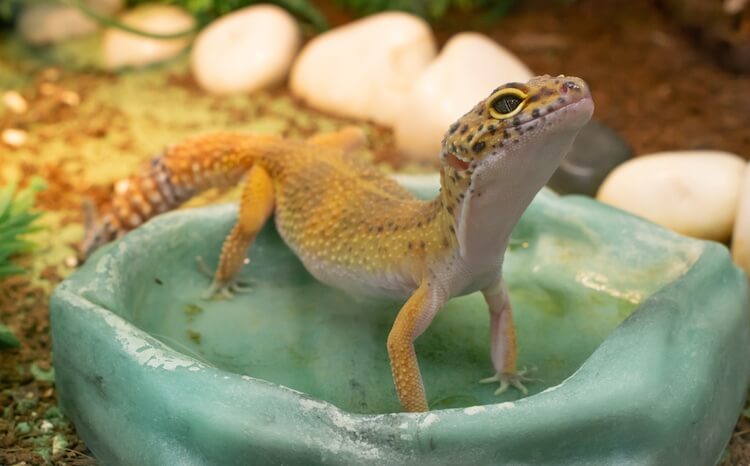
Unlike many popular lizards, leopard geckos should not eat fruits or vegetables.
Along with fruits and vegetables, there are several kinds of live prey and human foods that can cause health problems. Do not feed your gecko anything from this list:
- Chicken, beef, pork or processed meat
- Fish
- Dog, cat or ferret food
- Fireflies (a single firefly can kill a leopard gecko in minutes)
- Spiders
- Centipedes
Leopard geckos should also not eat foods made for other lizards. They should not eat crested gecko or bearded dragon food. These foods contain plant products that are not meant for them. They are unable to break down cellulose, a major component in plants, and do not have the right digestive system needed to digest them.
It may be tempting to catch wild insects, but this is not a good idea. Wild-caught insects should never be fed to your lizard.
Wild insects can carry parasites, disease or could be exposed to harmful chemicals. They can contain trace amounts of herbicides and pesticides that can be dangerous to your lizard.
Thankfully, leopard geckos are easy to feed and farm-raised insects can easily be bought.
Offering high-quality insects will keep your lizard much healthier. Foods with a low nutritional value, like earthworms, nightcrawlers, and weevils, should not be fed.
Many individuals enjoy freeze-dried insects as a treat, but this should not make up most of their diet. These foods lose many of their micronutrients through the drying process and do not trigger your gecko’s hunting instincts.
Common Feeding Mistakes
Leopard geckos are an easy lizard to feed, but there are still some mistakes made by new keepers.
1. Feeding Mealworms
Mealworms are a healthy option for adults, but they should be fed alongside other insects like crickets or cockroaches. Feeding just mealworms can lead to reduced growth and vitamin deficiencies.
Mealworms have a high ratio of chitin to meat, this makes them less nutritious than softer insects and harder to digest. Babies under four inches should not have mealworms at all.
2. Overfeeding
This species stores fat in their tail and is naturally chunky, but they can still become obese. Geckos love to eat. It is easy to give in and feed them more than they need. Keep your pet on a feeding schedule and watch for signs of over-eating.
A healthy gecko’s tail should be no wider than the width of its neck. Unless the tail was dropped, in that case, regrown tails tend to be shorter and fatter than regular tails.
3. Not Providing Calcium
Using a calcium supplement is very important for a healthy gecko. A lack of calcium causes metabolic bone disease and intestinal problems. Leopard geckos should also have UVB lighting to metabolize calcium into vitamin D3.
How Much Food To Feed Leopard Gecko?
Juveniles at six months or younger should be fed five to seven small crickets or Dubia cockroaches every day. Adults only need five large crickets and two mealworms every two days. Hornworms, waxworms and silkworms can be offered as treats once a week.
How Long Can A Leopard Gecko Go Without Food?
Hatchlings and juveniles grow very fast. Their weight gain should slow down as they reach a year old. However, if your yearling does not eat for more than four days, you should take it to a vet. Adults can go for over a week without eating when shedding. You should take adults to a vet if they refuse to eat for more than ten days.
Summary
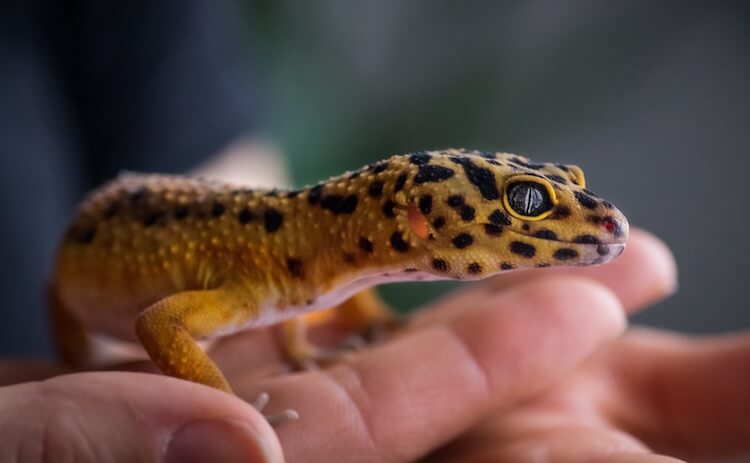
Leopard geckos are insectivores that need a completely meat-based diet of insects and other small invertebrates.
Varying the diet you feed by providing crickets and Dubia roaches will keep your gecko both happy and healthy. You can also feed hornworm and waxworms as an occasional treat.
Providing calcium and multivitamin powder, along with gut-loading insects before feeding them, will ensure your lizard gets the vitamins and minerals it needs.
With the right diet, your leopard gecko will thrive for over 15 years.
What foods does your gecko love? Let us know in the comments.

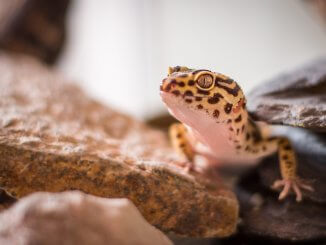
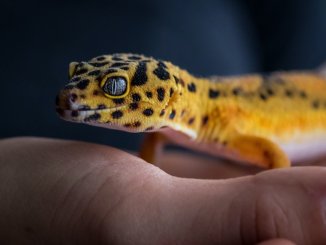
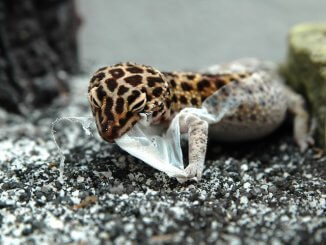

My gecko loves the pinkies(baby mice)